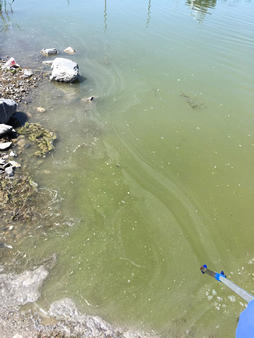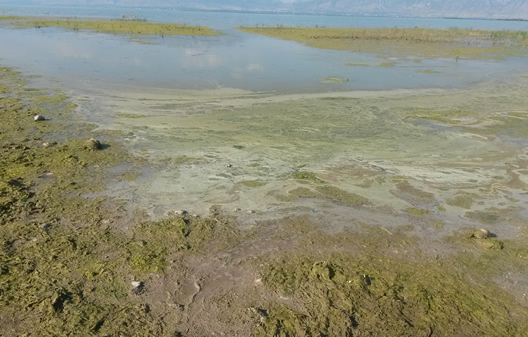News and Highlights
This is a list of past iUTAH EPSCoR news from 2012 to 2018.
October 26, 2017
Saline Lakes in Dire Situation Worldwide
iUTAH researchers Sarah Null and Maura Hahnenberger, and others have contributed to an article on the “Decline of the world’s saline lakes” published online in the journal Nature Geoscience on October 23, 2017.
An announcement written by Tracy Jones for Utah State Today says that saline lakes, including Utah's Great Salt Lake, are shrinking. While the lake has risen and fallen in recent years, this particular decline represents a drop in water level, exposing more lake bed, and leading to an increase in dust. In addition to the lake’s importance to economy, wildlife, and recreation, the dust caused by this decline is hazardous to human health. Authors of the article, including scientists and water managers, say that additional water resources are needed to bring the lake back to a healthy state.
Wayne Wurtsbaugh, lead author and professor in the Department of Watershed Resources and the Ecology Center at Utah State University says that “the persistence of water diversions has decreased the lake's level about 11 feet and exposed a lot of lake bed. The state's plans to continue developing water in the basin will only worsen the problem."
"The state has had some success in water conservation for households, but since water for agriculture represents over 60% of water use, domestic conservation represents only a minor reduction," says Wurtsbaugh. "Reductions in water use from all sectors will be needed if we are to solve this problem."
Full study of the article is available below:
“Decline of the world’s saline lakes”
Authors: Wayne Wurtsbaugh, Sarah Null, Peter Wilcock and Frank Howe of Utah State University; Craig Miller of the Utah Division of Water Resources, Justin deRose of the U.S. Forest Service, Maura Hahnenberger of Salt Lake Community College, and Johnnie Moore of the University of Montana.
Press: EurekAlert! | Utah State Today | The New York Times | International Business Times | Salt Lake Tribune
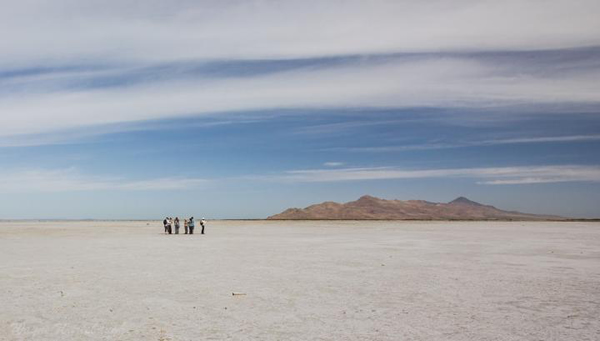
October 11, 2017
iUTAH Researcher Returns to Her Roots
Ka-Voka Jackson, a former iUTAH traineeship participant, has been in the news recently for her research on invasive grass in Glen Canyon. Jackson is leading a team of researchers in a project to learn how best to eradicate invasive ravenna grass from Lake Powell's side canyons and replant with native species. She is a University of Nevada, Las Vegas graduate student in ecology and evolutionary biology, and member of the Hualapai tribe. Here is what reporter Paige Blankenbuehler had to say about Jackson in an a High Country News article dated Sept. 6, 2017:
“With the Southwest’s climate on a trajectory for prolonged drought and weather extremes, Jackson navigates the deep backcountry near Glen Canyon, around the Arizona-Utah border. Here, back home, she is working to eradicate prolific and climate-change-resistant invasives and restore native vegetation….
As part of her graduate research, in collaboration with the National Park Service and Glen Canyon National Recreation Area, Jackson is now assessing dozens of plots, 100 square meters each, in five different canyons. …In April, she took a team of technicians into the canyons to kill or pull up ravennagrass and replant native plants. Jackson is also investigating whether passive re-vegetation — allowing the native plants to come back on their own — can work. Over the course of her program, she will return to monitor her plots, recording details from each to give land managers insight into which methods could work best for Glen Canyon National Recreation Area.”
Jackson is a graduate of the University of Utah, and has a Bachelor of Science in biology with an organismal and environmental emphasis. During her time with iUTAH, she was in the iUTAH Traineeship program and worked directly with the Red Butte Creek GAMUT technicians on their research, as well as other research scientists and graduate students.
Press: High Country News | Nevada Public Radio | Salt Lake Tribune | Utah Public Radio | KJZZ Radio
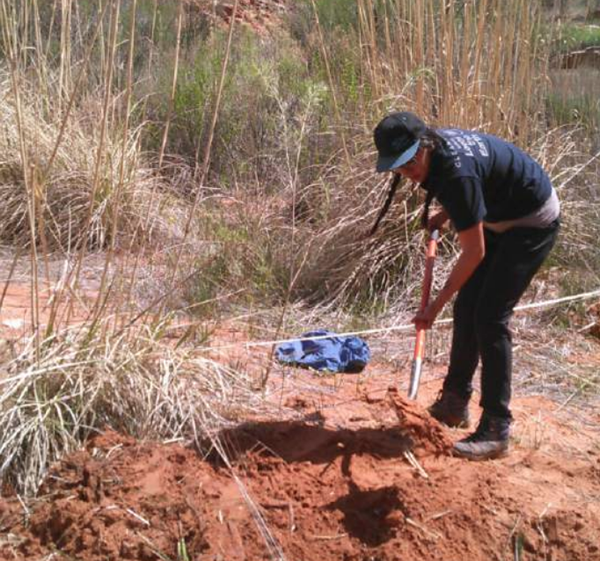
October 5, 2017
Classroom Lesson Leads to Publication
Former iUTAH postdoctoral researcher Erik Oerter has collaborated with Molly Malone, Louisa Stark, and Gabriel Bowen, and others to publish the paper “Every apple has a voice” in Hydrology and Earth System Sciences, a peer-reviewed open access journal.
In the summer of 2016, Oerter served as a mentor in the Summer Research Institute (SRI), a program supported by iUTAH from 2013 – 2016. The program offered students and teachers the chance to become scientists for one week each summer. He designed a one-day water science activity for the program, including lecture, a hands-on lesson about isotopes, food sourcing, and the water cycle, and a computer lab exercise. Participants, which included high school students, undergraduate students, and high school science teachers, then turned what they learned into a poster presenting their research results.
The effectiveness of the activity was assessed through pre- and post-lesson tests, as well as participant surveys. While the lesson was effective at teaching the basics of stable isotope hydrology and the water cycle, the computer lab needed to be more specifically tailored to each participant’s abilities. Oerter felt that he learned much from the teachers while discussing his lesson. A highlight of the week was “seeing the light bulb go on” in the students as they understand complex concepts while creating their posters.
Oerter is currently working as a postdoctoral researcher at Lawrence Livermore National Laboratory in Livermore, CA. His research focuses on the intersection of hydrology and geochemistry, applying the isotope hydrology expertise gained through iUTAH to a broader set of national issues.
Originally, SRI was designed as part of CI-Water, a prior NSF EPSCoR-funded project that brought collaborating institutions in Utah and Wyoming together to address water issues in the West. Through the guidance of Director Louisa Stark and Senior Education Specialist Molly Malone from the Genetic Science Learning Center at the University of Utah, the program engaged 96 high school students and teachers, and undergraduates in 13 diverse research projects reflecting iUTAH's cross-disciplinary approach over four years.
Full study of the article is available below:
“Every apple has a voice: using stable isotopes to teach about food sourcing and the water cycle.”
Authors: Erik Oerter, Molly Malone, Annie Putman, Dina Drits-Esser, Louisa Stark, and Gabriel Bowen.
Related news article:
Collaborative Paper wins HESS Best Paper Award
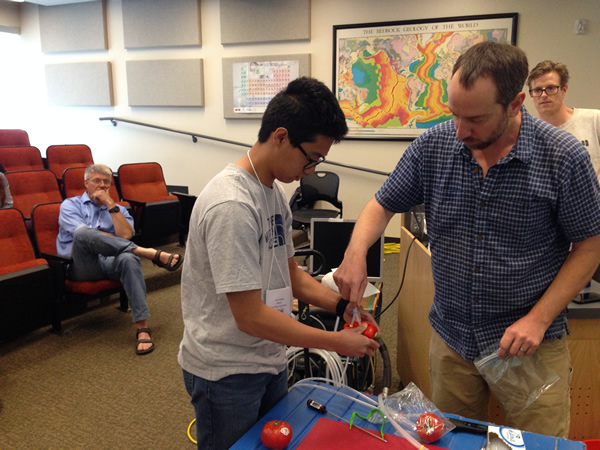
Credit: Molly Malone, GSLC/University of Utah
September 15, 2017
Publication Features Two Papers on iUTAH Water Science
As the iUTAH project comes to a close, researchers are summarizing methodology and findings as it applies to other water-related research. The September issue of the Journal of the American Water Resources Association (JAWRA) features two in-depth reviews of the mountain urban water system in Utah, specifically, iUTAH design, implementation, and maintenance of sensor equipment, data and metadata produced by the water science project.
The first paper, “Designing and Implementing a Network for Sensing Water Quality and Hydrology across Mountain to Urban Transitions” discusses the logistics of developing and maintaining the Gradients Along Mountain to Urban Transitions (GAMUT) network. The article described the practices followed, as well as insights and findings during the installation and operation of GAMUT. Early on, the research team focused on openly publishing data to drive further science. The research teams “worked to balance scientific needs with physical site limitations, communication constraints, public engagement goals, site security, and partnership potential.” Once the groundwork was laid for the project, additional enhancements focused on quality assurance and system controls to manage and communicate the numerous large datasets produced. The paper finds that GAMUT the "is underlying infrastructure that serves as a vehicle for other research endeavors, ” and instills confidence in consistent long-term data output which secondary users might find helpful after applying their own assessments.
The second paper, “Data Management Dimensions of Social Water Science: The iUTAH Experience” focuses more specifically on integrating a social science framework into the project. It reinforces the first article’s discussion of planning and policy needs, as it explores the open science, data sharing, and the human aspect of Utah’s water system. The study recommends classifying social water science data according to the dimensions of human subject data, primary vs. secondary data, and data restrictions to reveal opportunities and reduce barriers for data sharing. Furthermore, the article concludes by saying that “by facilitating innovative approaches to managing a diverse portfolio of data, the iUTAH program has furthered understanding of a mountain urban water system and provided opportunities for data integration across water sciences and between science and society.”
Full study of each article available below:
Designing and Implementing a Network for Sensing Water Quality and Hydrology across Mountain to Urban Transitions
Authors: Amber Spackman Jones, Zachary T. Aanderud, Jeffery S. Horsburgh, David P. Eiriksson, Dylan Dastrup, Christopher Cox, Scott B. Jones, David R. Bowling, Jonathan Carlisle, Gregory T. Carling, and Michelle A. Baker
Data Management Dimensions of Social Water Science: The iUTAH Experience
Authors: Courtney G. Flint, Amber Spackman Jones, and Jeffery S. Horsburgh
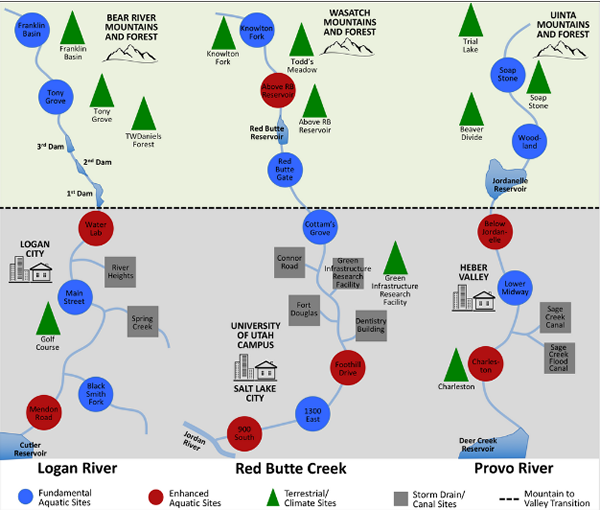

August 16, 2017
iUTAH Research Links Urbanization to Groundwater Degradation
In a recent paper published in Environmental Science & Technology, iUTAH researchers examined the mountain-to-urban transition in Utah watersheds, specifically Red Butte Creek, to identify mechanisms by which urbanization impacts water quality. The article, published on July 21, 2017, found that urban-driven changes in water quality plays a significant role in urban degradation of surface water quality. After the sample analysis discussions, findings point to challenges of current water quality management and restoration efforts based on the use of popular stormwater management strategies in urban settings. Authors of the article include Rachel S. Gabor, Steven J. Hall, David P. Eiriksson, Yusuf Jameel, Mallory Millington, Trinity Stout, Michelle L. Barnes, Andrew Gelderloos, Hyrum Tennant, Gabriel J. Bowen, Bethany T. Neilson, and Paul D. Brooks.
The article can be viewed under the title “Persistent Urban Influence on Surface Water Quality via Impacted Groundwater.”

Credit: Rachel Gabor, et al.
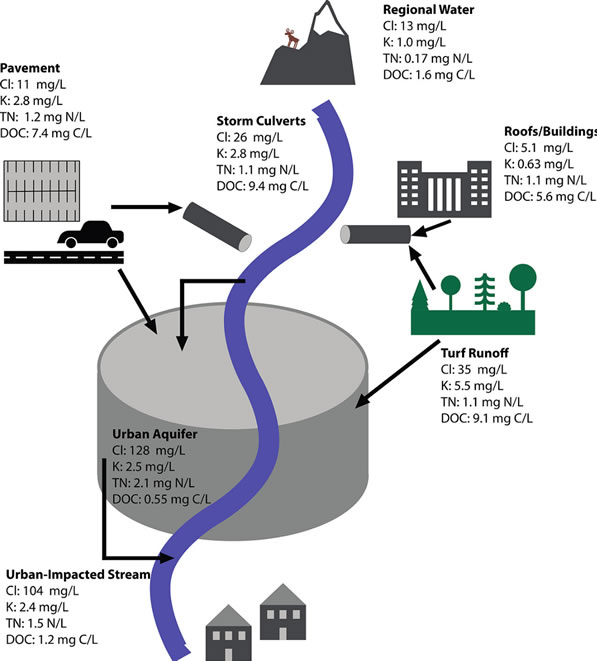
August 9, 2017
BYU Researchers Study Utah Lake Algal Bloom
iUTAH researchers Erin Jones and Scott Collins, along with associate professor Zachary Aanderud and GAMUT technician, Dylan Dastrup, have been in the news recently in connection with their research of Utah Lake’s algae phenomenon. Here’s what the research team and state agencies had to say to reporter Anna Bryner, in an excerpt from the August 3 article in Brigham Young University’s The Daily Universe:
“‘Once isolated, we can put (the cyanobacteria) in controlled environments and manipulate just a few variables at a time to really establish the values for which the bacteria respond by either growing exponentially or producing toxins,’ Jones said.
The team will also analyze the nutrient levels of the varying forms of phosphorous and nitrogen in the lake. ‘We’ll be able to see what factors correlate with the algal growth for the different species that we find from sequencing,’ said Jones. ‘By (taking samples) weekly, we hope to be able to catch conditions leading up to blooms, which is where the environmental triggers actually occur.’
The researchers have also been collecting extra samples to send to the Utah Department of Environmental Quality, where the samples are analyzed to provide information to the public. ‘They’re a real big help for us because we don’t have the resources to go down there on a weekly basis,’ said Ben Holcomb, environmental scientist for the Utah Division of Water Quality.
According to Jones, collecting an extra sample for the department is ‘not really much of a sacrifice.’ ‘They’re spread pretty thin, so we’re happy to do what we can to help contribute to the public health awareness that the cyanobacteria represent,’ Jones said.
As part of the collaboration, the Utah Department of Environmental Quality provides data to the researchers about the analysis of the samples. ‘It saves us a little bit of money and time by them being able to provide that analysis for us,’ Jones said. According to Holcomb, the benefits are mutual. ‘We’re kind of complimenting each other on our needs, so it’s been a really helpful process,’ Holcomb said.
According to Donna Spangler, the Utah Department of Environmental Quality communications director, algal blooms are naturally occurring. The conditions that cause blooms to spread include sunlight, heat, stagnant water and an excess of nutrients. ‘Under certain environmental conditions … (algal bloom) certainly has a tendency to spread,’ she said.”
Read the full article below for more details on how the iUTAH/BYU research team and state agencies are working together to help protect public health.
Press: The Daily Universe | Deseret News
